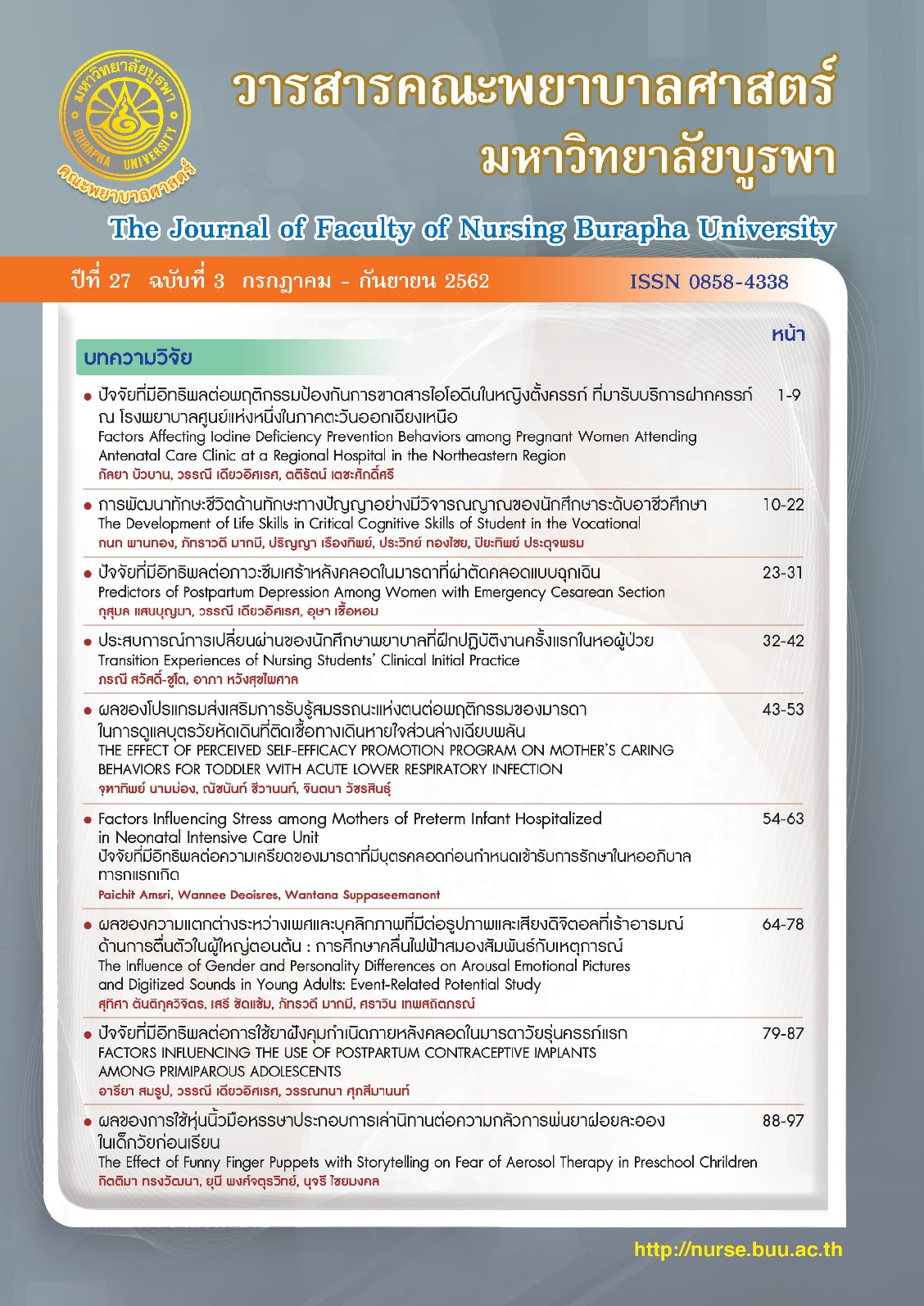การพัฒนาทักษะชีวิตด้านทักษะทางปัญญาอย่างมีวิจารณญาณ ของนักศึกษาระดับอาชีวศึกษา
คำสำคัญ:
ทักษะชีวิต, โปรแกรมฝึกทักษะชีวิต, ทักษะทางปัญญาอย่างมีวิจารณญาณ, อาชีวศึกษาบทคัดย่อ
บทคัดย่อ
การวิจัยนี้มีวัตถุประสงค์เพื่อพัฒนาทักษะชีวิตด้านทักษะทางปัญญาอย่างมีวิจารณญาณของนักศึกษาอาชีวศึกษา โดยเก็บข้อมูลเชิงคุณภาพด้วยการสัมภาษณ์ และสนทนากลุ่มจากผู้บริหารและผู้เกี่ยวข้อง 128 คน เชิงปริมาณจากกลุ่มนักเรียน/นักศึกษา 2,869 คน ในสถานศึกษาสังกัดสำนักงานคณะกรรมการการอาชีวศึกษาด้วยวิธีการสุ่มแบบหลายขั้นตอน เครื่องมือวิจัยประกอบด้วย แบบสอบถามความต้องการจำเป็นในการพัฒนาทักษะชีวิตCCS ของนักศึกษาอาชีวศึกษา แบบสัมภาษณ์แบบมีโครงสร้างแนวทางการมีส่วนร่วมในการพัฒนาทักษะชีวิต CCS ของนักศึกษาอาชีวศึกษา แบบประเมินทักษะชีวิต CCS โปรแกรมฝึกทักษะชีวิต CSS วิเคราะห์ข้อมูลเชิงคุณภาพด้วยการวิเคราะห์เนื้อหา ข้อมูลเชิงปริมาณวิเคราะห์ด้วยสถิติพรรณา ประเมินความต้องการจำเป็น และสถิติทดสอบค่าที
ผลการวิจัยพบว่า ผู้บริหารและผู้เกี่ยวข้องมีส่วนร่วมพัฒนาทักษะชีวิตด้านทักษะทางปัญญาอย่างมีวิจารณญาณ และต้องการให้ผู้เกี่ยวข้องมีส่วนร่วมด้านการประเมินผลสูงสุด ส่วนนักเรียน/นักศึกษามีความต้องการจำเป็นให้พัฒนาทักษะชีวิตด้านการคิดอย่างมีวิจารณญาณสูงสุด เกณฑ์ประเมินทักษะชีวิต CCS แบ่งเป็น ระดับดีมาก ดี และพอใช้ โปรแกรมฝึกทักษะชีวิต CCS ที่พัฒนาขึ้น ออกแบบให้เน้นที่ผู้เรียนเป็นสำคัญ ส่งเสริมทักษะ การคิด ปฏิบัติ และเรียนรู้อย่างมีความสุข ซักถาม แลกเปลี่ยนความคิดเห็นได้ตลอดเวลา 10 กิจกรรม ผลการประเมินมีความเหมาะสมมากที่สุด (M=4.51) ค่าเฉลี่ยคะแนน CCS กลุ่มทดลองหลังใช้โปรแกรมฝึกทักษะชีวิตฯ สูงกว่าก่อนใช้อย่างมีนัยสำคัญทางสถิติที่ระดับ .05 และหลังทดลองกลุ่มใช้โปรแกรมฝึกทักษะชีวิตฯ มีค่าเฉลี่ยคะแนน CCS สูงกว่ากลุ่มไม่ใช้อย่างมีนัยสำคัญทางสถิติที่ระดับ .05 และนักเรียนมีความพึงพอใจโปรแกรมฝึกทักษะชีวิตฯ โดยรวมในระดับมากขึ้นไป
เอกสารอ้างอิง
Batchelder, W. H., & Alexander, G. E. (2012). Insight problem solving: A critical examination of the possibility of formal theory. The Journal of Problem Solving, 5(1), 6.
Botvin, G.J. (2006). Life Skills Training: Promoting Health and Personal Development. Princeton Health.
Chadcham, S. (2001). Hand Book of 433306 Classical Test Theory. Department of Educational Research and Measurement, Faculty of Education, Burapha University. [In Thai]
Charan, J., & Biswas, T. (2013). How to calculate sample size for different study designs in medical research?. Indian journal of psychological medicine, 35(2), 121-126.
Chompoopan, W., & Banchonhattakit, P. (2012). Effects of Development Program of Life Skills on Stress Management Behavior Promotion among the Emergency Medical Technician Students of Sirindhorn College of Public Health, KhonKaen. Srinagarind Medical Journal, 27(3), 302-309. [In Thai]
Cohen, J. M., & Uphoff, N. T. (1977). Rural Development Participation: Conceps and Measures for Project Design, Implementation and Evaluation. New York: The Rural Development Committee Center for International Studies, Cornell University.
Edmonds, W. A., & Kennedy, T. D. (2017). An applied reference guide to research designs: quantitative, qualitative, and mixed methods (2nd ed.). Thousand Oaks: SAGE.
Guilford, J. P. (1967). The Nature of Human Intelligence. New York: McGraw-Hill.
Lewis, A., & Smith, D. (1993). Defining higher order thinking. Theory into Practice, 32 (3), 131-137.
Macmillan Education. (2016). Macmillan life skills language is a life skill. Retrieved May 13, 2017, from http://www.macmillanenglish.com/life-skills.
Mangrulkar, L., Whitman, V. C., & Posner, M. (2001). Life Skills Approach to Child and Adolescent Healthy Human Development. Pan American Health Organization.
Office of the Basic Education Commission. (2014). Guidelines for organizing a life skill training camp: The problems can be stopped with the power of children and youth. Bangkok: OBEC. [In Thai]
Pinitjitsamut, M. (2009). Dialogue: science of intelligence creative in human. Bangkok: Monotheme Consulting. [In Thai]
Pinyoanuntapong, S. (2015). Development of Teacher Training Program for Promoting Young Children’s Social and Emotional Development. Journal of Education: Faculty of Education, Srinakharinwirot University, 16(1), 76-94. [In Thai]
Royal Thai Government Gazette. (2013). Notification of Ministry of Education on Thai Qualifications Framework for Vocational Education (TQF:VEd) 2013. Retrieved May 13, 2017, from http:// bsq2.vec.go.th/rule.html. [In Thai]
Samsudin, K. A., & Ismail, A. (2004). The improvement of mental rotation through computer based multimedia tutor. Malaysian Online Journal of Instructional Technology (MOJIT), 1(2), 24-34.
Sinthapanon, S., Wannalerslak, W., & Sinthapanon, P. (2009). Thinking Skill Development for Success Teching (3th ed.). Bangkok: Liangchiang. [In Thai]
Strickland, O. L., Lenz, E. R., & Waltz, C. (2010). Instrumentation and data collection. In Measurement in nursing and health research (4th ed.). New York: Springer Publishing.
Treerattananukool, S., & Makmee, P. (2017). Participation for Development of Life Skills of Students in Phanomsarakham Industrial and Community Education College, Chachoengsao Province. Rajabhat MahaSarakham University Journal, 11(3), 185-196. [In Thai]
Umpote, K. (2015). Training curriculum development. Retrieved June 30, 2016, from http://www.tu.ac.th/
org/ofrector/person/train/hanbook/course.html. [In Thai]
Wongpiromsarn, Y., & Ruangkanchanasetr, S. (2009). Life Skill.Retrieved February 11, 2017, from http://resource.thaihealth.or.th/library/11142. [In Thai]
World Health Organization. (1993). Life skills education in schools. WHO.
World Health Organization. (1994). Life skills education for children and adolescents in schools. Pt. 1, Introduction to life skills for psychosocial competence. Pt. 2, Guidelines to facilitate the development and implementation of life skills programmes. Geneva: World Health Organization Retrieved May 13, 2017, from http://www.who.int/iris/handle/10665/63552.
World Health Organization. (1997). Life skills education in schools (revised edition). Geneva: World Health Organization-Program on Mental Health. 1-7.





